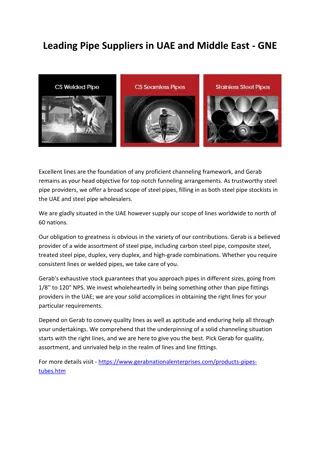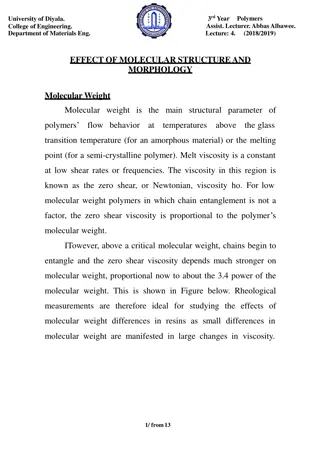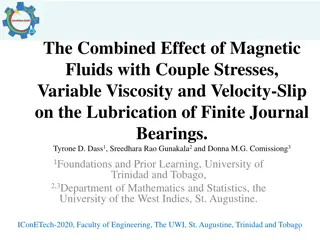Investigating Phase Inversion and Viscosity in Pipe Flow
This study explores the effects of varying oil percentages on flow patterns, pressure drop, holdup, and viscosity in multiphase pipe flow. The research methodology includes testing rigs and applying theories for calculating liquid holdup and pressure drop. Results include insights into flow patterns observed and the calculation of viscosity for further analysis.
Download Presentation

Please find below an Image/Link to download the presentation.
The content on the website is provided AS IS for your information and personal use only. It may not be sold, licensed, or shared on other websites without obtaining consent from the author.If you encounter any issues during the download, it is possible that the publisher has removed the file from their server.
You are allowed to download the files provided on this website for personal or commercial use, subject to the condition that they are used lawfully. All files are the property of their respective owners.
The content on the website is provided AS IS for your information and personal use only. It may not be sold, licensed, or shared on other websites without obtaining consent from the author.
E N D
Presentation Transcript
PHASE INVERSION AND VISCOSITY IN PIPE FLOW Laura Edwards, Dhurjati Prasad Chakrabarti Department of Chemical Engineering The University of The West Indies St Augustine IConETech-2020, Faculty of Engineering, The UWI, St. Augustine, Trinidad and Tobago
INTRODUCTION Multiphase flow is a general term to define the simultaneous flow of two or more phases Knowledge of hydrodynamics of this flow is significant. Emulsions, or the dispersion of one immiscible phase into other, are found in oil production and processing facilities where crude oil can be found to be mixed with water in the presence of naturally occurring emulsifiers. The change of continuous phase from oil to water or water to oil is termed as phase inversion (Chakrabarti, Das and Das 2006). IConETech-2020, Faculty of Engineering, The UWI, St. Augustine, Trinidad and Tobago
INTRODUCTION Figure 1: a) water-continuous and b) oil-continuous phase in a pipe IConETech-2020, Faculty of Engineering, The UWI, St. Augustine, Trinidad and Tobago
OBJECTIVES The effects of increased oil percentage on the following parameters were investigated: Flow pattern Pressure drop Holdup Viscosity IConETech-2020, Faculty of Engineering, The UWI, St. Augustine, Trinidad and Tobago
METHODOLOGY Figure 2: Test rig for multiphase flow IConETech-2020, Faculty of Engineering, The UWI, St. Augustine, Trinidad and Tobago
RESULTS To estimate liquid holdup or pressure drop, Taitel and Dukler (1976) theory is extended for calculation. Momentum balance for the liquid phase will be: IConETech-2020, Faculty of Engineering, The UWI, St. Augustine, Trinidad and Tobago
RESULTS Viscosity, L, is calculated based on Edwards, et al. (2018). Pressure drop can be eliminated from equations 3 and 4 to yield equation 12. Equation 12 is solved to get holdup and pressure drop. IConETech-2020, Faculty of Engineering, The UWI, St. Augustine, Trinidad and Tobago
RESULTS Figure 3: Flow patterns observed IConETech-2020, Faculty of Engineering, The UWI, St. Augustine, Trinidad and Tobago
RESULTS Figure 4: Flow regime map at 40% oil cut IConETech-2020, Faculty of Engineering, The UWI, St. Augustine, Trinidad and Tobago
RESULTS Figure 5: Flow regime map at 65% oil cut IConETech-2020, Faculty of Engineering, The UWI, St. Augustine, Trinidad and Tobago
RESULTS Figure 6: Holdup and prediction IConETech-2020, Faculty of Engineering, The UWI, St. Augustine, Trinidad and Tobago
RESULTS Figure 7: Pressure drop and prediction IConETech-2020, Faculty of Engineering, The UWI, St. Augustine, Trinidad and Tobago
CONCLUSION The addition of oil to the liquid phase causes a dampening effect on the flow regime transition, most considerably from stratified to non-stratified flow. Experimental data for pressure drop and holdup are deviated largely from prediction up to +31%. This investigation is done mostly by normal video camera and image processing. It is recommended to have high speed camera, conductivity probe or optical probe for flow pattern detection in a finer way. IConETech-2020, Faculty of Engineering, The UWI, St. Augustine, Trinidad and Tobago
REFERENCES D.P. Chakrabarti, G. Das, P. K. Das. The Transition from Water Continuous to Oil Continuous Flow Pattern. AIChE J 59 no 11 (2006) 3668 3678. A. H. Selker, Jr C. A. Sleicher. Factors affecting which phase will disperse when immiscible liquids are stirred together, Canadian Journal of Chemical Engineering 43 no 6 (1965) 298 301. M. A. Norato, C. Tsouris, L. L. Tavlarides. Phase inversion Studies in Liquid-Liquid Dispersions. Canadian Journal of Chemical Engineering. 76 no 3 (1998) 486-494. J. M. Zaldivar, M. A. Alos, E. Molga, H. Hernandez, K. R. Westerterp. The effect of phase inversion during semibatch aromatic nitrations. Chemical Engineering and Processing. 34 (1995) 529 542. IConETech-2020, Faculty of Engineering, The UWI, St. Augustine, Trinidad and Tobago
REFERENCES S. Arirachakaran, K. D. Oglesby, M. S. Malinowsky, O. Shoham, J. P. Brill. An analysis of oil/water flow phenomena in horizontal pipes. In: SPE Paper 18836, SPE Prod. Operating Symp., Oklahoma, March 13-14, 1989; 155-167. G. Yeh, F. H. Haynie Jr, R. E. Moses. Phase-volume relationship at the point of phase inversion in liquid dispersions. AIChE Journal. 10 no 2 (1964) 260 265. N. Brauner, A. Ullmann. Modelling of phase inversion phenomenon in two-phase pipe flow. International Journal of Multiphase Flow 28 no 7, (2002) 1177-1204. A. K. Chesters, R. Issa. A Framework for the Modelling of Phase Inversion in Liquid-Liquid Systems. 5th International Conference on Multiphase Flow, ICMF 04. Yokohama, Japan, May 30 June 4, 2004. Paper No. 271. IConETech-2020, Faculty of Engineering, The UWI, St. Augustine, Trinidad and Tobago
REFERENCES T. W. F. Russell, M. E. Charles. The effect of the less viscous liquid in the laminar flow of two immiscible liquids. Canadian Journal of Chemical Engineering 37 no 1 (1959) 18-24. D. P. Chakrabarti, G. Das, P. K. Das. Liquid-Liquid Two-Phase Flow through an Orifice; Chemical Engineering & Technology 196 no 9 (2009) 1117-1129. D. P. Chakrabarti. Prediction of Phase Split in Horizontal T Junctions: Revisited; Chemical Engineering & Technology, 37 no 10 (2014) 1813-1816. P. Vigneaux, P. Chenais, J. P. Hulin. Liquid-liquid flows in an inclined pipe. AIChE Journal 34 no 5 (1988) 781-789. IConETech-2020, Faculty of Engineering, The UWI, St. Augustine, Trinidad and Tobago
REFERENCES Angeli P, Hewitt GF. Flow structure in horizontal oil-water flow. International Journal of Multiphase Flow 26 no 7 (2000) 1117-1140. Y. Taitel, A. E. Dukler. A model for predicting flow regime transitions in horizontal and near horizontal gas liquid flow 22 no 1 (1976) 47-55. J. Hapanowicz, L. Troniewski. Two-phase flow of liquid liquid mixture in the range of the water droplet pattern. Chemical Engineering and Processing 41 no 2 (2002) 165 172. R. Pal, Pipeline flow of unstable and surfactant-stabilized emulsions. AIChE Journal 39 no 11 (1993) 1754-1764. IConETech-2020, Faculty of Engineering, The UWI, St. Augustine, Trinidad and Tobago
REFERENCES L. Edwards, D. Jebourdsingh, D. Dhanpat, D. P. Chakrabarti, Hydrodynamics of air and oil water dispersion/ emulsion in horizontal pipe flow with low oil percentage at low fluid velocity. l., Cogent Engineering 5 (2018) 1494494. N.Brauner, J.Rovinsky, D.Moalem Maron. Determination of the interface curvature in stratified two-phase systems by energy considerations. Into J Multiphase Flow 22 no 6 (1996) 1167-1185. IConETech-2020, Faculty of Engineering, The UWI, St. Augustine, Trinidad and Tobago
THANK YOU! IConETech-2020, Faculty of Engineering, The UWI, St. Augustine, Trinidad and Tobago























